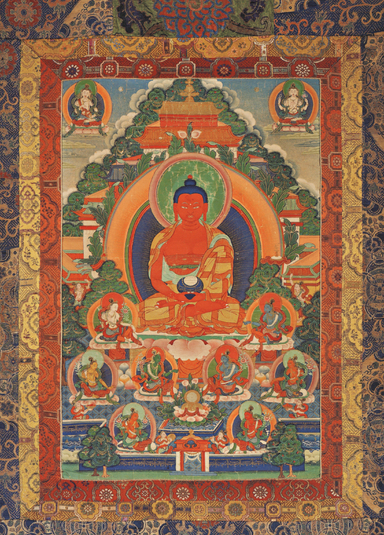
Item: Amitabha Buddha - Nirmanakaya
| Origin Location | Tibet |
|---|---|
| Date Range | 1900 - 1959 |
| Lineages | Gelug and Buddhist |
| Material | Ground Mineral Pigment on Cotton |
| Collection | Private |
Classification: Deity
Appearance: Buddha
Gender: Male
Amitabha Buddha (Tibetan: san gye o pame. English: the Buddha of Boundless Light) is located in the pureland of Sukhavati teaching to the eight great bodhisattvas, shravakas and pratyekabuddhas seated in front.
Seated in the perfect posture of meditation, red in colour with one face and two hands, blue-black hair in tufts with a red top-knot ornament and the split ears of a prince, he wears the patched saffron robes of a fully ordained monk. The two hands are placed in the lap in the mudra (gesture) of meditation and hold a black begging bowl filled with nectar. With the two legs folded in vajra posture seated above a pink lotus and peacock supported throne, he is surrounded by a dark blue and orange nimbus and green areola under a canopy mounted in a wish-fulfilling tree blossoming behind with various flowers and fruits, adorned with hanging jewels. At the sides, heavenly gods on white clouds shower down precious jewels, wishing gems and flower blossoms.
Seated in front and to the sides of Amitabha are the Eight Great Bodhisattvas, 'the heart sons of the Buddha,' each with their own colour, attribute and a gesture: Avalokiteshvara, Maitreya, Kshitigarbha, Samantabhadra, Vajrapani, Manjushri, Akashagarbha and Nivarana-vishkhambhin.
At the upper left side is the deity of purification Vajrasattva. At the upper right side is the four-armed Chaturbhuja Avalokiteshvara.
There are many different Buddhas represented in art. Following after the images of the historical Buddha Shakyamuni the next most common Buddha form to appear in art is likely to be Amitabha (immeasurable light). His popularity is based in the Mahayana Sutra literature of which there are many texts devoted to him. In art depictions Amitabha has two appearances. He can have the appearance of a standard buddha form (nirmanakaya), red in colour, wearing the traditional patchwork robes of a monk. In his other appearance (sambhogakaya) he wears the clothing and jeweled adornments of a peaceful heavenly god according to the classical Indian system of divine aesthetics. The source literature for Amitabha Buddha are texts such as the Display of the Pure Land of Sukhāvatī (Sukhāvatīvyūha), the Incantation of Amitābha (amitābhadhāraṇīmantra), Calling Amitābha to Mind and the Dhāraṇī Praising the Qualities of the Immeasurable One.
In the Himalayan and Tibetan traditions there is a great deal of conflation between the two buddhas - Amitabha and Amitayus. In the early sutra literature Amitabha and Amitayus Buddha are not the same entity, or person. (For a detailed explanation of the differences between Amitabha and Amitayus see the introduction to the Aparimitāyurjñāna Sūtra: Aparimitāyus, Amitāyus, and Amitābha).
Jeff Watt 4-2022
Source Texts:
Toh 115. The Display of the Pure Land of Sukhāvatī. Sukhāvatīvyūha, ’phags pa bde ba can gyi bkod pa zhes bya ba theg pa chen po’i mdo. 84000: Translating the Words of the Buddha
Toh 677/864. The Incantation of Amitābha. སྣང་མཐའི་གཟུངས་སྔགས། · snang mtha'i gzungs sngags. amitābhadhāraṇīmantra.
Toh 678/867. Calling Amitābha to Mind. སྣང་མཐའ་རྗེས་སུ་དྲན་པ། · snang mtha' rjes su dran pa.
Toh 679/851. The Dhāraṇī Praising the Qualities of the Immeasurable One. ཡོན་ཏན་བསྔགས་པ་དཔག་ཏུ་མེད་པའི་གཟུངས། · yon tan bsngags pa dpag tu med pa’i gzungs. Aparimitaguṇānuśāṁsadhāraṇī.
Toh 680/889. Essence of Sukhāvatī. བདེ་ལྡན་གྱི་སྙིང་པོ། · bde ldan gyi snying po.
Buddhist Deity: Amitabha Buddha Main Page (阿弥陀佛 / འོད་དཔག་མེད།)
Collection of the National Museum of Asian Art (Shrine)
Collection of the National Museum of Asian Art (Atelier Series)
